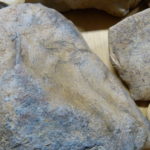_+ Spheniscus Sinensis Sinteticum
SPHENISCUS SINENSIS SINTETICUM
chart, photo, videos, paper sculpture, scientific documentation, drawings
2013
I dissected minuscule samples of plastic from the exemplar found within the Antarctic Museum, and had the samples analyzed in various laboratories: under the microscope at the Department of Environmental Science (Dr. Francesca Droghini), under the 3D microscope of the Department of Physical, Earth, and Environment Sciences (Dr. Francesco Boschin, Crozzini Jacopo), and with the University of Siena in fields related to environmental chemistry, cultural heritage, and ecotoxicology (Dr. Cristina Gueranti). I decided to work with the same means used in scientific research as a creative performance process.
The results served to throw light another aspect of contemporary society, which is often unaware of the things by which it is surrounded. The same superficiality that allows museum visitors to accept the plasticized fetish reappears in the purchase of apparently insignificant, funseeming objects that prove harmful to the environment. Plastic objects frequently hide illegal trafficking in the world of crime syndicates in China, which resell toxic waste required by law, at least in principle, to receive special disposal. Instead, such toxic waste is often washed with nothing but water and then transformed into objects such as toys for children. The chart, in this specific case, is like an instruction booklet to undertake the journey of this newest species of penguin, which can then create new links as prompts for further knowledge. In the process of studying and analyzing this Asian penguin, I used photos taken in Antarctica during “my first voyage” in search of this new species, whichI did not find, but which I nonetheless succeeded in learning about thanks to the study of the great quantity of plastic found in the waters of the Antarctic, the analysis of which revealed the plastic’s provenance from Asian currents.


